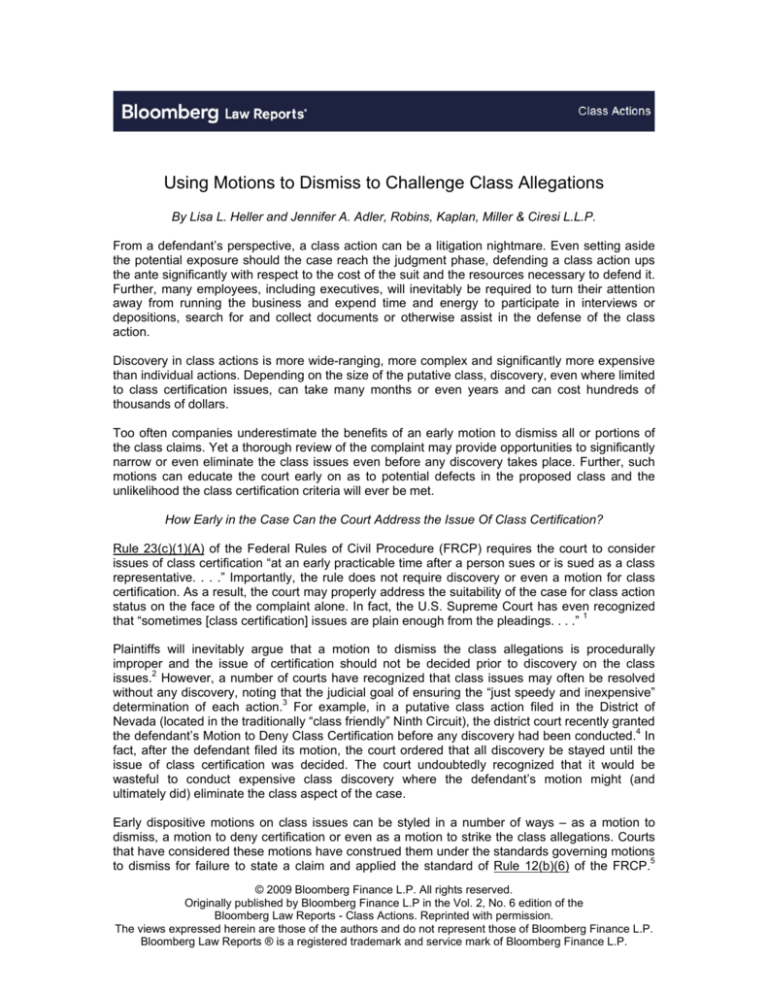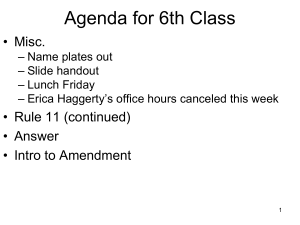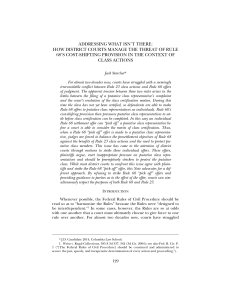
Using Motions to Dismiss to Challenge Class Allegations
By Lisa L. Heller and Jennifer A. Adler, Robins, Kaplan, Miller & Ciresi L.L.P.
From a defendant’s perspective, a class action can be a litigation nightmare. Even setting aside
the potential exposure should the case reach the judgment phase, defending a class action ups
the ante significantly with respect to the cost of the suit and the resources necessary to defend it.
Further, many employees, including executives, will inevitably be required to turn their attention
away from running the business and expend time and energy to participate in interviews or
depositions, search for and collect documents or otherwise assist in the defense of the class
action.
Discovery in class actions is more wide-ranging, more complex and significantly more expensive
than individual actions. Depending on the size of the putative class, discovery, even where limited
to class certification issues, can take many months or even years and can cost hundreds of
thousands of dollars.
Too often companies underestimate the benefits of an early motion to dismiss all or portions of
the class claims. Yet a thorough review of the complaint may provide opportunities to significantly
narrow or even eliminate the class issues even before any discovery takes place. Further, such
motions can educate the court early on as to potential defects in the proposed class and the
unlikelihood the class certification criteria will ever be met.
How Early in the Case Can the Court Address the Issue Of Class Certification?
Rule 23(c)(1)(A) of the Federal Rules of Civil Procedure (FRCP) requires the court to consider
issues of class certification “at an early practicable time after a person sues or is sued as a class
representative. . . .” Importantly, the rule does not require discovery or even a motion for class
certification. As a result, the court may properly address the suitability of the case for class action
status on the face of the complaint alone. In fact, the U.S. Supreme Court has even recognized
that “sometimes [class certification] issues are plain enough from the pleadings. . . .” 1
Plaintiffs will inevitably argue that a motion to dismiss the class allegations is procedurally
improper and the issue of certification should not be decided prior to discovery on the class
issues.2 However, a number of courts have recognized that class issues may often be resolved
without any discovery, noting that the judicial goal of ensuring the “just speedy and inexpensive”
determination of each action.3 For example, in a putative class action filed in the District of
Nevada (located in the traditionally “class friendly” Ninth Circuit), the district court recently granted
the defendant’s Motion to Deny Class Certification before any discovery had been conducted.4 In
fact, after the defendant filed its motion, the court ordered that all discovery be stayed until the
issue of class certification was decided. The court undoubtedly recognized that it would be
wasteful to conduct expensive class discovery where the defendant’s motion might (and
ultimately did) eliminate the class aspect of the case.
Early dispositive motions on class issues can be styled in a number of ways – as a motion to
dismiss, a motion to deny certification or even as a motion to strike the class allegations. Courts
that have considered these motions have construed them under the standards governing motions
to dismiss for failure to state a claim and applied the standard of Rule 12(b)(6) of the FRCP.5
© 2009 Bloomberg Finance L.P. All rights reserved.
Originally published by Bloomberg Finance L.P in the Vol. 2, No. 6 edition of the
Bloomberg Law Reports - Class Actions. Reprinted with permission.
The views expressed herein are those of the authors and do not represent those of Bloomberg Finance L.P.
Bloomberg Law Reports ® is a registered trademark and service mark of Bloomberg Finance L.P.
Under this standard, the “well-pleaded” allegations of the complaint are accepted as true and
read in a light favorable to the plaintiff and the class allegations will be dismissed if the proposed
class cannot be certified as a matter of law. 6
Thus, a motion to dismiss the class aspects of a case may be filed even before the defendant
answers the complaint.
Is the Class Adequately Defined?
One of the most fundamental requirements of any class action is that the class must be defined in
a manner such that it is “ascertainable.” Both the court and the parties must be able to reasonably
identify who would be a member of the class. Although this is not an express requirement under
Rule 23, a determination of whether the class is adequately defined is a necessary prerequisite to
class certification.7 It goes without saying that if the class is not adequately defined such that its
members are identifiable, it cannot be certified. Accordingly, an attack on the sufficiency of the
class definition may be a means to narrow class issues early on in the case.
Does the Class Definition Require a Determination of Liability?
Where a class is defined in such a manner that the court must determine the ultimate issue of
liability in the case, it cannot be certified because the court is unable to determine who is included
in the class before a trial on the merits.8 Courts thus find these types of classes to be
unascertainable and “self-defeating” since the burden of conducting mini-trials on the merits of
each putative class member’s case negates the efficiency of the class action vehicle.9 The most
obvious example of this is where the class is defined as consisting of all persons who may have
been injured or harmed by the wrongful conduct alleged in the complaint.10 To determine who
would be included in such a class, the court would have to determine what, if any, “harm” was
suffered by each putative class member.
Is the Class Definition Too Vague or Indefinite?
A class must consist of an identifiable group of plaintiffs. Courts have refused to certify a class
where the class definition is too vague or indefinite such that it would be impossible to identify
what putative class members would be bound by the action. For example, in an employment
discrimination case, a class of applicants who were allegedly deterred from applying for
employment by the defendant’s discriminatory employment policies was held unascertainable
because membership in the proposed class was dependent upon the state of mind of each class
member.11 Likewise, a class of persons “active in the peace movement who [had] been harassed
and intimidated as well as those who fear[ed] harassment and intimidation in exercising their First
Amendment right of free expression” was found to be inadequately defined because the class
was too imprecise and amorphous.12
It may be obvious from the proposed class definition in the complaint that there is no realistic way
to determine who belongs in the class in advance of a trial or that membership in the class
depends upon the mental state of the putative class members. Under these circumstances, it
behooves a defendant to file a motion to dismiss to put this issue before the court.
Do Individualized Issues Of Law Or Fact Overwhelm Common Issues?
The plaintiff in a class action has the burden to show not only that common issues exist, but that
they predominate over individual questions. It can often be determined from the complaint
whether these types of individualized inquiries, either of fact or law, would overwhelm the case
and thus make it inappropriate for class treatment. Potential red flags include:
•
Do putative class members reside in multiple states, potentially
implicating the law of multiple states?
•
•
•
Does the plaintiff allege a number of state law claims?
Does the plaintiff allege the defendant violated a statute, agreement
or duty through various acts that are committed over a period of
time?
Are multiple agreements, over a significant period of time, involved?
The presence of these types of allegations may be an indication that the plaintiff is unable to meet
the requirements of Rule 23 and therefore a motion to dismiss is appropriate.
The basic premise of a class action is that the claims of the class members have common
elements, and therefore the most efficient means to resolve those claims is in one forum. For this
reason, Rule 23(b)(3) requires that common questions of fact or law not only exist but
“predominate over questions affecting only individual members” and that the class action must be
“superior” to other means for adjudicating the case. It follows that where the claims of the class
members are overwhelmed by individualized issues, the class cannot be certified. It may be clear
from the face of the complaint without any discovery that individualized issues will predominate
and defeat class certification. For example, a plaintiff who seeks to certify a nationwide class of
state law claims – which must be decided on the basis of the law of multiple states – sometimes
cannot meet Rule 23(b)(3)’s predominance requirement because the legal issues do not pose a
common question.
Courts have refused to certify nationwide classes based upon products liability and breach of
contract theories on the basis that there was no manageable way to deal with the variances in
state laws.13 Class actions alleging violations of state deceptive trade practices statutes create
similar problems. These types of claims often vary from state to state, making it impossible for the
court to resolve claims of numerous plaintiffs who reside in various states. In fact, where class
members reside in a number of states, simply to ascertain what substantive law applies to each
class member’s claim requires an individualized choice of law analysis for each class member.
Individualized issues of fact can also preclude class treatment as a matter of law. In breach of
contract cases, for example, individualized inquiries may be necessary to determine whether a
breach of a contract has occurred even where the agreement at issue is a standard agreement.
For example, if plaintiffs allege that the defendant breached an agreement in a number of
different ways, individualized issues could easily predominate over common questions. The
Eleventh Circuit in Klay v. Humana, Inc., 382 F.3d 1241, 1255 (11th Cir. 2004), found that
individualized issues of fact predominated over common issues on breach of contract claims
alleged by a putative class of doctors against HMOs, stating that “each doctor, for each alleged
breach of contract (that is, each alleged underpayment), must prove the services he provided, the
request for reimbursement he submitted, the amount to which he was entitled, the amount he
actually received, and the insufficiency of the HMO’s reasons for denying full payment.” Klay, 382
F.3d at 1264.
A Motion to Dismiss Can Alert the Court as to the Class Issues
Strategic thinking in any class action should include the possibility of an early motion to dismiss
on class issues. Such a motion, regardless of whether it is granted, can be a cost efficient way to
curtail litigation costs and streamline the case. Even if the court chooses to dismiss the class
claims without prejudice (to allow plaintiff to recast his class allegations) or denies the motion
given the early juncture in the litigation, the motion can still provide a valuable opportunity to
educate the court as to the class issues. Additionally, if the court recognizes the potential for the
case to become unmanageable, it may be willing to narrow the proposed class or curtail the
discovery allowed on the question of class certification.
Lisa L. Heller is the Managing Partner of the Atlanta office of Robins, Kaplan, Miller & Ciresi
L.L.P. Her practice focuses on complex business litigation, including class action defense.
Jennifer A. Adler is an associate in the Atlanta office of Robins, Kaplan, Miller & Ciresi L.L.P. Her
practice focuses in the area of business litigation, including class action defense.
1
Gen. Tel. Co. of the Southwest v. Falcon, 457 U.S. 147, 160 (1982).
At least one court has specifically rejected this argument on the basis that, under the directive of Rule 23,
class issues should be decided as soon as practicable. See Saunders v. Bell South Adver. & Publ'ng Corp.,
12 Fla. L. Weekly Fed. D 92 (S.D. Fla. Nov. 10, 1998).
3
Fed. R. Civ. P. 1.
4
Picus v. Wal-Mart Stores, Inc., Nos. 07-cv-00682, 07-cv-00686, 07-cv-00689, 2009 BL 53475 (D. Nev.
March 16, 2009).
5
Walls v. Wells Fargo Bank, N.A. (In re Walls), 262 B.R. 519, 524 (E.D. Cal. 2001)(“. . . the motion to deny
class certification, having been brought prior to any discovery, should be construed according to the same
legal standards as a motion to dismiss under Rule 12”).
6
Bell Atl. Corp. v. Twombly, 550 U.S. 544 (2007).
7
See, e.g., De Bremaecker v. Short, 433 F.2d 733, 734 (5th Cir. 1970); Mad Rhino, Inc. v. Best Buy Co.,
Inc., No. 03-cv-05604 (C.D. Cal. Jan. 14, 2008).
8
8 Newberg on Class Actions, § 24.17 (4th ed. 2008).
9
Forman v. Data Transfer, 164 F.R.D. 400, 404 (E.D. Pa. 1995) (plaintiff’s proposed class definition was
untenable where a determination of class membership “would essentially require a mini-hearing on the
merits of each case”).
10
Conigliaro v. Norwegian Cruise Line, No. 05-cv-21584 (S.D. Fla. Aug. 31. 2006) (class of cruise
passengers “who suffered either physical injury, and/or emotional injury, and/or had their cruise ruined” was
impermissibly vague and “unavoidably” implicated the merits of the case).
11
Harris v. Gen. Dev. Corp., 127 F.R.D. 655, 659 (N.D. Ill. 1989).
12
DeBremaecker v. Short, 433 F.2d 733, 734 (5th Cir. 1970).
13
See, e.g., Zinser v. Accufix Research Inst., Inc., 253 F.3d 1180, 1189 (9th Cir. 2001); McFarland v.
Memorex Corp., 96 F.R.D. 357 (N.D. Cal. 1982); Lozano v. AT&T Wireless Servs., 504 F.3d 718, 728 (9th
Cir. 2007).
2





